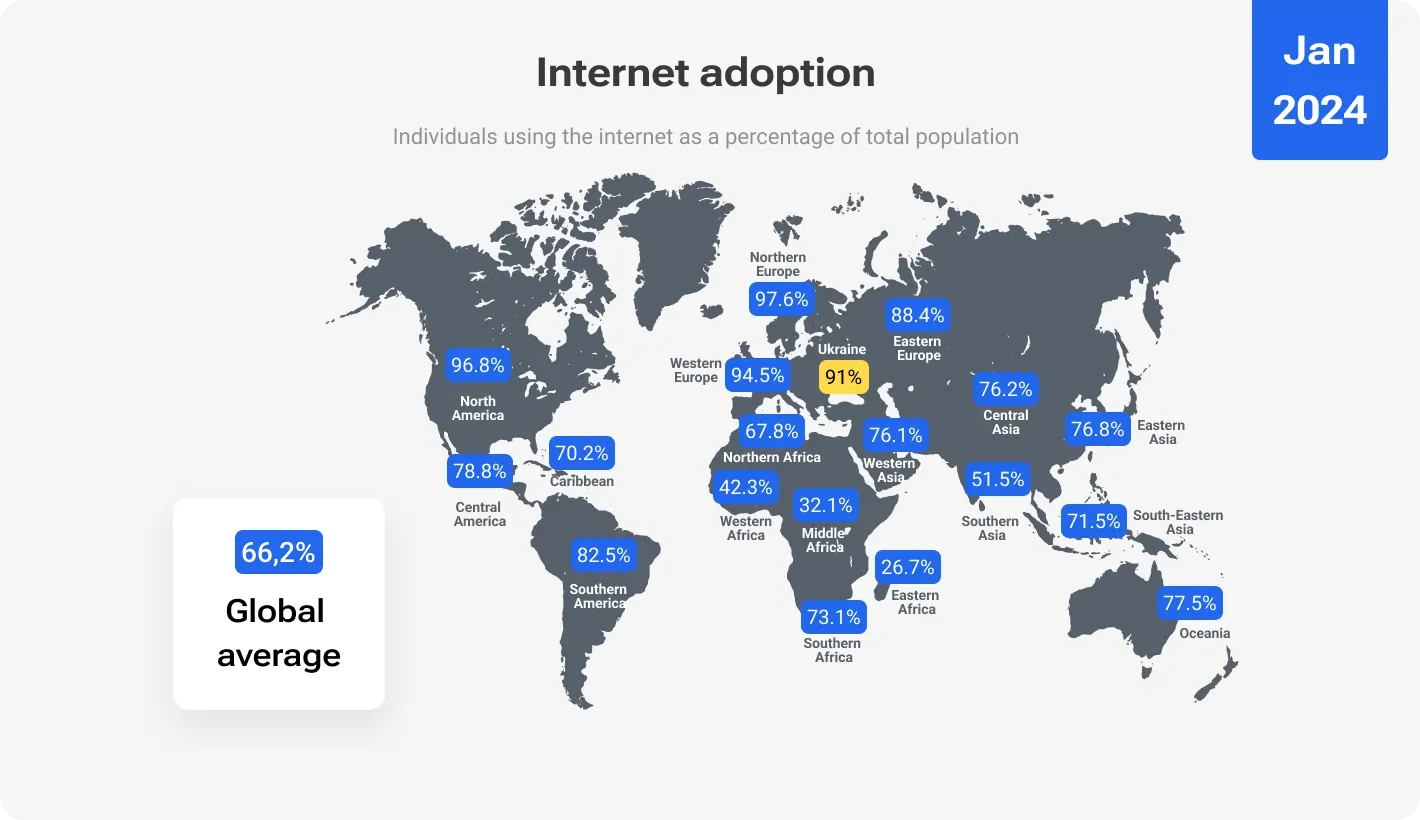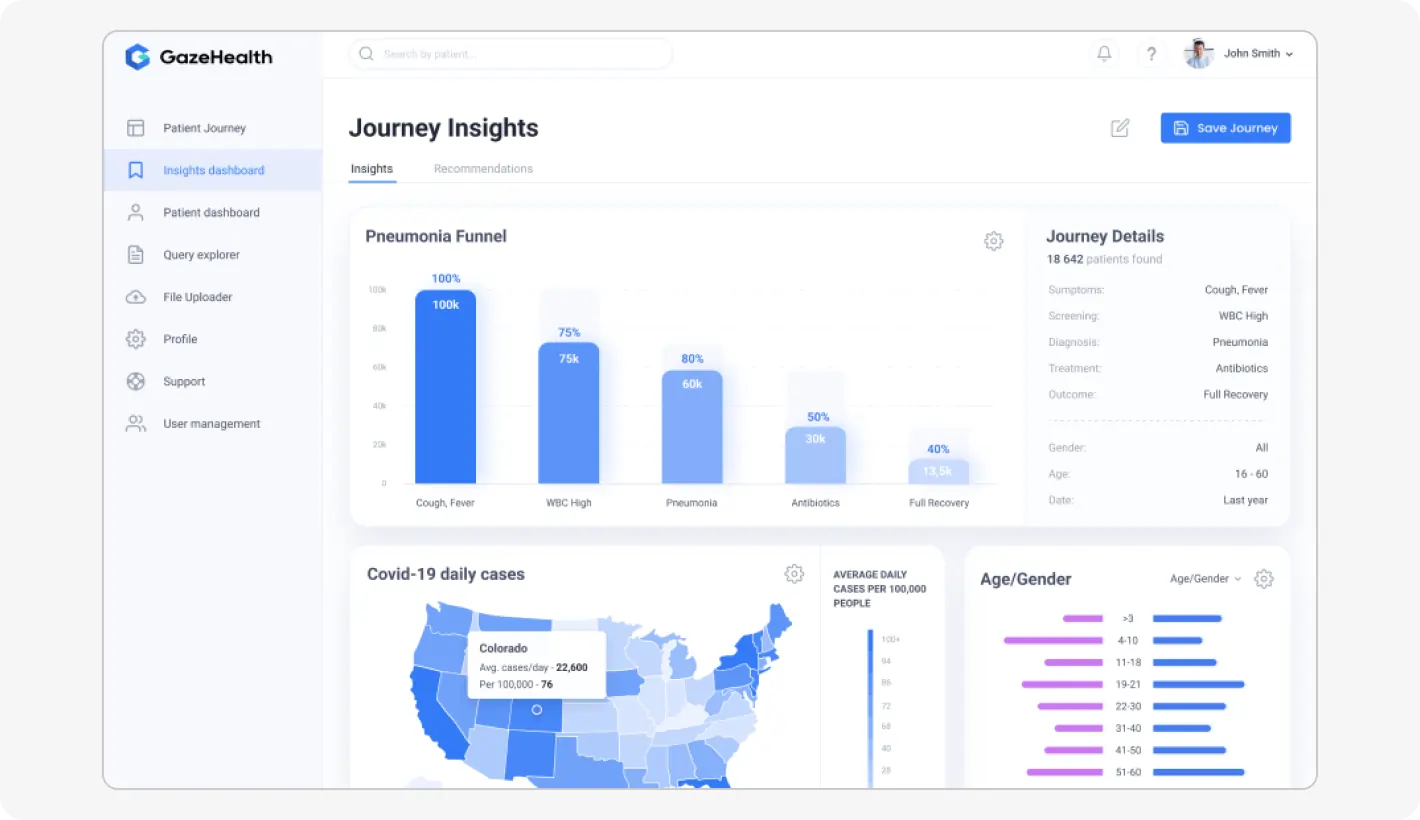The US and Britain face a pronounced skill and talent gap, particularly in the tech sector. Korn Ferry firmly predicts that by 2030, the global talent shortage could reach over 85M people, costing economies USD 8.5 trillion in unrealized annual revenues. And the tech industry stands at the forefront of this challenge.
Another interesting POV was provided by the WEF Report in 2020. 94% of tech leaders expect their employees to pick up new skills and admit that over 40% of their current workforce needs upskilling in 6 months or less.
This is a thing — spending on upskilling doesn’t guarantee that “upgraded” specialists won’t leave your company. But when there is a question, there is an answer too.
Enter offshore product development. Imagine having access to a pool of highly skilled developers at a fraction of the cost — that's the essence of the offshore development model. It's comparable to sourcing rare ingredients from across the globe to craft a perfect dish, where the ingredients are skilled developers and the dish is a completed software project.
End to end solutions with predictable budgets, a time to market advantage with budget savings of up to 50%
Offshore product development services offer tantalizing benefits: significant cost savings, access to a vast pool of talent, and the ability to operate around the clock. For companies navigating modern business challenges, it represents a path to thrive.
We aim to illuminate the intricacies of this approach, offering CEOs and C-suite executives the insights needed to harness its full potential, from selecting the right partners to managing cross-cultural teams and ensuring project success.
Deciding if offshore development is right for you
Onshore software development is gradually moving away from the first plan in building modern business models. And here's why.
But there is a thing, too. The decision without taking into account the inherent complexities and challenges that come along with offshore or onshore models can be just blind.
Key factors to consider
-
Project complexity: The scope of the project may be too complex and intricate. If your project doesn’t require frequent face-to-face interactions, you can hire outsourced product management professionals without harming the typical for your workflow.
-
Budget constraints: A primary motivator for outsourcing software development offshore is the potential for significant cost savings. If budget limitations are a pressing concern, this model can provide access to cost-effective solutions without compromising on quality.
-
Expertise required: List specific skills and expertise your project demands. Offshore development opens up a global talent pool that may not be offered by an onshore team.
Overcoming challenges
We already mentioned some challenges of software development outsourcing. More obvious challenges are cultural and language barriers, time zone differences, and managing quality and productivity. Nonetheless, there are some difficulties, but there are solutions.
Determine clear communication channels and regular check-ins to mitigate misunderstandings.
Adapt working hours slightly to have overlapping hours for real-time collaboration.
You should have quality control processes and maintain active involvement in project management to ensure standards are met.
Alternatives to consider
Onshore development: This outsourcing model means assigning all the scope to a team located within your own country. This way, you get easier communication and similar time zones but may not provide the same cost savings as offshore options.
Nearshore development: Outsourcing to a neighboring country. Like if you are in the US, you can outsource to Canada or LatAm countries. This way, you strike a balance between cost savings and geographic proximity, potentially mitigating some communication challenges
Accenture case
You may not know Accenture. But they are considered an outsourcing leader in the world. The company stands as a testament to the successful implementation of outsourcing projects. Accenture significantly boosted its revenue, reporting over USD 64 billion in the fiscal year 2023. By the way, those numbers underscore the 4% increase from 2022. Well, the clear-cut proof of the offshore development potential.
Choosing an offshore development partner
Selecting the right offshore product development company is a critical step that can determine the further way of your project. There are endless criteria you should pay attention to, but some of them are even more important than others.
Essential criteria
Experience and expertise: First and foremost, your potential partner must have a proven track record in your industry or with similar project types. Use Clutch. Although the platform has lost a bit of credibility in the last year (now, it has about 40 points according to SEMRUSH in the US), it still allows you to make the right choice, filtering companies by industry, location, and expertise and providing valuable insights into potential partners' experience. It’s also worth checking whether your project requires location-based knowledge. For example, if your project is related to dating, food delivery, or any other location-tracking software, it makes sense to check a partner's knowledge of the local “circumstances”.
Cultural compatibility: The matter Clutch doesn’t cover. But as they say, there is an app for that, too. Tools like Hofstede Insights can be helpful in identifying potential cultural differences and how to bridge them. In addition, a couple of intro meetings may close the gap.
Communication style: Effective communication is vital for offshore development success. Assess their responsiveness, language proficiency, and preferred communication tools to ensure they match your expectations.
Security measures: Given the sensitive nature of software development, your partner must have robust security protocols in place to protect your data and intellectual property. Look for certifications like ISO 27001, an internationally recognized standard for information security management systems.
Technical nuances: Assess the area where you outsource. For example, check the internet adoption and its cost. By the way, Ukraine has one of the cheapest Internet costs for 100 Mbps.
Top tips on researching and vetting potential partners
Online reviews and ratings: We’ve already mentioned Clutch. A similar one is GoodFirms. They offer reviews and ratings of software development companies worldwide. These sites provide detailed feedback on companies' performances, client satisfaction, and project management capabilities.
Case studies and client references: Ask for case studies similar to your project and review their portfolio. Reputable partners will also provide client references without any hesitation. Don’t shy away from contacting these references directly to inquire about their experiences working with the potential partner.
Security audit: Request information on their security measures and compliance certifications. For highly sensitive projects, consider conducting a security audit through third-party services to ensure your data will be in safe hands.
Technical evaluation: Chances are there is a possibility to do a meeting withpotential partner. Such a technical interview could focus on a code review to assess their technical proficiency. Some companies opt for a trial project to evaluate the partner’s capabilities in a real-world scenario.
How to get IT staff augmentation right
Setting up for success
Previously, we mentioned the general steps of planning an offshore software development project. Let’s elaborate on that since beyond the foundational aspects of planning and communication, there are several actionable strategies, tools, and best practices that can significantly enhance the likelihood of project success.
Define clear project scope and requirements
A little remark — we understand that it’s a corny suggestion, but still crucial. If you have ever participated in marketing strategy sessions, chances are you got the ball rolling from the final ideal result and your current position in the market. Here, we have a similar situation — you should reckon your current tech position and resources to picture the final result.
Detailed documentation: Don’t shy away from creating comprehensive documentation outlining project goals, functionalities, user stories, and acceptance criteria. Even the most common tools like Google Docs or Microsoft Teams will match the task. They offer real-time editing and ensure all stakeholders, including your offshore team, are on the same page.
Mockups and wireframes: Develop clear visual representations of the user interface (UI) and user experience (UX) (Figma or Adobe XD will be helpful). These visual aids bridge communication gaps as previously mentioned tools.
Refine communication and overcome time zone challenges
Structured schedules: You definitely could do with a structured schedule that defines clear windows of overlapping work hours. Nothing can be better in aligning than real-time communication. Arm with scheduling tools like World Time Buddy to find optimal meeting times that bridge the gap between different time zones.
Cultural sensitivity training: Without any pathos, cultural sensitivity matters. When you compare onshore vs offshore software development, try to take into account local nuances, even those that are not related to work. Train both your in-house and offshore teams. Understanding and respecting each other’s cultural backgrounds can prevent misunderstandings and ensure a cohesive working environment. Use Aperian (GlobeSmart), this way, you’ll get resources and training to improve cross-cultural communication.
Meet expectations effortlessly
Technical onboarding: To mitigate risks related to quality and ensure the offshore team fully understands your project’s technical requirements, conduct comprehensive technical onboarding sessions. Consider interactive platforms like Miro for collaborative brainstorming and Lucidchart for visualizing architecture, ensuring that everyone is aligned on technical standards and expectations.
Continuous integration/continuous deployment (CI/CD): Implement CI/CD pipelines to automate the testing and deployment of code. Discover Jenkins, integrated with AI capabilities for predictive analytics. It helps to identify potential issues before they become problematic. In addition, the 2020 State of DevOps Report stated that high-performing teams are 24X more likely to fully automate their configuration management than low performers.
Intellectual property (IP) security and data protection matter
Legal frameworks and NDAs: Sooner or later, you’ll need strong legal frameworks and non-disclosure agreements (NDAs). Many use general templates of such agreements, but in an ideal world, they should be tailored to the specific needs of your project and the jurisdictions involved. In this case, it’s worth using LegalZoom. At least, you can choose from many templates and consultancy for creating robust legal agreements that protect your intellectual property and data.
Secure collaboration tools: Use secure collaboration tools that comply with international data protection regulations. For instance, Tresorit or Wire. They offer end-to-end encrypted communication and file-sharing capabilities, ensuring that your project’s data remains protected. Even if your niche is not strictly regulated, you will have a leg-up, because nobody knows where the breach can happen.
By the way, Devico develops solutions even to the strict-regulated niches, like healthcare. For example, we engaged in the creation of GazeHealth, a healthcare platform containing both an EMR system and an analytics tool. We ensured secure collecting, visualizing, and managing data about patients, ensuring mental health specialists could separately track and study case records of different patient groups.
Better with each iteration
Innovation labs: Set up virtual innovation labs where your in-house and offshore teams can collaboratively explore new technologies and methodologies. This initiative can lead to breakthroughs in how challenges are addressed and foster a culture of continuous improvement.
Feedback loops and retrospectives: Establish regular feedback loops and retrospectives using tools like Retrium. This allows teams to reflect on what worked well and what didn’t, turning challenges into opportunities for growth and innovation.
Building a long-term partnership
Good relationship with the onshore team is not rocket science. It also has particular difficulties, however, it’s much easier to solve them. Creating a sustainable and positive relationship with an offshore product development company goes beyond typical Friday’s pizzas, IYKYK. It’s about laying the groundwork for a long-term partnership that benefits both parties. Here's how CEOs can foster such relationships.
Some psychological tips
Focus on shared goals: When it comes to cross-cultural teams, many often look for differences. And they should look for what unites such teams. Make up something like an internal contest, gamify the process, and celebrate milestones together.
Empathy and understanding: For the project duration, empathy must become your best friend the main skill. Recognize cultural differences and approach to communication. We’ve already mentioned GlobeSmart by Aperian above; it’s a relevant tool for gaining insights into your partner's cultural values and communication styles.
Regular appreciation: During your contest or even without it, show appreciation for your offshore team's hard work. A simple thank you, or a virtual team-building activity can go a long way in boosting morale and strengthening the bond.
Encourage ownership and autonomy: Empowering the team to take ownership of their tasks fosters a sense of responsibility and pride in their work. Set clear expectations but give them the freedom to approach challenges creatively.
Building trust and transparency
Regular communication: It’s better to have a constant rhythm of check-ins, daily or weekly, and ensure that these interactions are not just transactional but also include open dialogues about challenges and concerns. Video calls can create a more personal connection than emails or messages.
Open feedback: Create a safe environment for giving and receiving constructive feedback. It might seem like an ad, but it’s not — GlobeSmart offers insights into cultural preferences and communication styles; just a kind reminder.
And a just-once-again reminder about cultural sensitivity training, trust us: it helps to celebrate cultural diversity within your team; at least, it helps nip any issues in the bud.
Benefits of a long-term partnership
Reliability and trust: Over time, a long-term partnership with an offshore development team leads to a deep mutual understanding and trust. This reliability translates to smoother project flows and quicker turnaround times.
Cost efficiency: Establishing a stable relationship reduces the need for frequent onboarding and training, leading to better cost efficiency and allocation of resources.
Quality and innovation: Long-term partners better understand your business goals and can contribute more effectively to innovation and quality improvement, having a vested interest in your success.
To sum it up
The global software development landscape presents exciting opportunities, but also talent gaps that can hinder your company's growth. However, there are still strategies to leverage offshore product development services effectively.
Remember, the key to success lies in careful planning, choosing the right partner, and establishing a strong foundation for collaboration. Define project requirements clearly, prioritize single-channel and regular communication, and foster a culture of trust — this is the only way you can unlock the true potential of outsourcing software development offshore.
Consider exploring extra resources for additional insights and best practices. Like Clutch, GoodFirms, Nearshore Americas — they provide valuable resources and industry reports on offshore and nearshore development.
Stack Overflow also could be helpful. It’s an online community for developers, offering a wealth of information and discussions on various software development topics, including outsourcing considerations.
As the tech landscape continues to evolve, your game-changer is to outsource product development; this will undoubtedly play a key role in shaping the future. Are you ready to leverage its potential?
Augment your tech teams with our developers, adding the expertise you need








